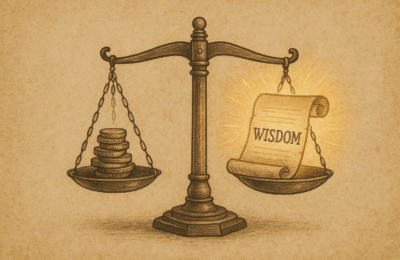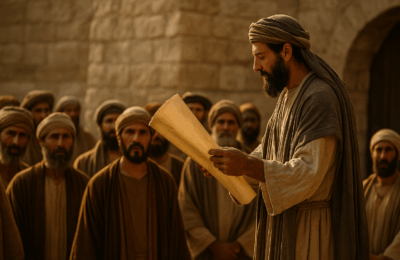Home | Bible Resources | Historical Books
1 Chronicles: A Call to Remember: Covenant, Kingship, and the Promise of Restoration
Introduction
At first glance, 1 Chronicles might seem like a repetition of earlier biblical history—but it’s much more. Written after the Babylonian exile, this book reframes Israel’s past to ignite hope for the future. With a priestly tone and a kingly focus, 1 Chronicles retells the story of David, not to glorify him, but to anchor post-exilic Israel in God’s covenant faithfulness and messianic promise. By tracing genealogies back to Adam and re-centering on the Davidic covenant, the Chronicler calls God’s people to return to worship, revere the temple, and reestablish their identity around the rule of YHWH through His chosen King. For modern believers, 1 Chronicles reinforces the importance of remembering God’s faithfulness, anchoring our identity in His promises, and placing our hope in the coming Son of David—Jesus Christ.
1. Title, Author, and Date
1 Chronicles derives its name from the Greek Paralipomenon, meaning “things left out,” but it is not merely supplementary—it’s a retelling with theological intent.
- Hebrew Title: דִּבְרֵי הַיָּמִים (Divrei Hayamim) — “The Words/Acts of the Days”
- Greek Title: Paraleipomenon — “The Things Omitted”
- Traditional Author: Ezra the Scribe (Jewish and early Christian tradition)
- Date of Writing: ~450–425 BC, post-exilic period
- Historical Setting: Written to returning exiles in Judah; reflects the need to reconnect with their spiritual heritage, national identity, and temple-centered worship.
Role in Redemptive History: 1 Chronicles reinforces the Davidic covenant and temple worship as central to Israel’s hope for restoration. It transitions the storyline from exile to anticipation, anchoring future messianic expectation in past divine promises.
Book Stats Sidebar
Chapters: 29
Verses: 942
Approx. Word Count (LSB): ~20,365
2. Purpose and Themes
1 Chronicles reshapes Israel’s historical memory to renew covenantal hope. It exalts David’s kingship, emphasizes temple centrality, and underscores God’s unwavering promises.
Central Purpose:
To remind post-exilic Israel of their covenant identity by recounting genealogies, highlighting David’s faithful kingship, and re-centering worship in the temple.
Major Doctrines Emphasized:
- Davidic Covenant (1 Chronicles 17)
- Temple Worship and Priestly Order
- Messianic Hope through David’s Line
- Covenant Faithfulness of God
- Sacred Memory and Historical Theology
Literary Features:
- Extensive genealogies (chs. 1–9) grounding identity in creation and covenant
- Theologically selective retelling of David’s reign (chs. 10–29)
- Liturgical focus: Levites, priests, musicians, temple preparation
- Omission of David’s failures (e.g., Bathsheba), emphasizing ideal kingship
3. Outline
1 Chronicles moves from Israel’s deep past to David’s godly leadership, presenting history through a redemptive lens to rekindle hope among the exiles.
I. Genealogical Foundations: From Adam to David (1:1–9:44)
A. Adam to Israel’s Tribes (1:1–2:55)
B. David’s Royal Line and Judah’s Centrality (3:1–4:43)
C. Tribal Genealogies (5:1–8:40)
D. Jerusalem’s Inhabitants and Levitical Duties (9:1–44)
II. The Rise of Davidic Kingship (10:1–12:40)
A. Saul’s Death and David’s Rise (10:1–11:9)
B. David’s Mighty Men and Army (11:10–12:40)
III. The Ark, Worship, and Covenant (13:1–17:27)
A. David Brings the Ark to Jerusalem (13:1–16:43)
B. David’s Psalm of Thanksgiving (16:7–36)
C. The Davidic Covenant Promised (17:1–27)
IV. David’s Rule and Military Victories (18:1–20:8)
A. Expansion of the Kingdom (18:1–20:8)
V. Census and Consecration (21:1–27:34)
A. David’s Sinful Census and God’s Mercy (21:1–30)
B. Temple Site Identified at Mount Moriah (22:1)
C. Temple Preparation and Organization (22:2–27:34)
VI. David’s Final Acts and Solomon’s Anointing (28:1–29:30)
A. David’s Charge to Solomon and the People (28:1–21)
B. Offerings and Worship (29:1–22)
C. Solomon Crowned; David’s Death (29:23–30)
Canonical Flow: 1 Chronicles rewinds the narrative to reframe Israel’s identity post-exile. It bridges the genealogical past with David’s kingdom, setting the stage for 2 Chronicles’ focus on Solomon and temple-centered restoration.
4. Key Themes and Theological Contributions
1 Chronicles invites God’s people to remember who they are by remembering who God is: faithful to His covenant, sovereign in His promises, and worthy of worship.
Major Themes:
- Covenantal Memory: Genealogies reinforce divine faithfulness from creation through David.
- Davidic Ideal: Emphasis on David’s role as a model king and covenant recipient.
- Worship-Centered Leadership: Temple preparation and Levitical order dominate David’s final acts.
- Messianic Hope: David’s eternal dynasty prefigures Christ’s unending reign.
Typology and Redemptive Motifs:
- David as a type of Christ, the Shepherd-King who unites Israel and prepares for temple worship.
- Temple site at Mount Moriah, where Abraham offered Isaac (Genesis 22), becomes a shadow of ultimate sacrifice.
- Genealogical continuity links Adam → Abraham → David → Messiah (cf. Matthew 1:1)
📌 Memory Verse: 1 Chronicles 17:14 (LSB) — “But I will establish him in My house and in My kingdom forever, and his throne shall be established forever.”
⚔️ Major Rebellions / Turning Points:
1. Saul’s Death and the End of Illegitimate Kingship (10:1–14)
Israel’s first king dies due to unfaithfulness—setting the stage for God’s chosen ruler.
2. David’s Census and Divine Mercy (21:1–30)
Though David sins in numbering Israel, God reveals mercy and designates the future temple site.
3. The Covenant of an Eternal Throne (17:1–27)
God sovereignly establishes a covenantal promise pointing directly to the Messiah.
5. Christ in 1 Chronicles
Christ is the ultimate fulfillment of the promises made to David—the eternal King who builds a temple not made with hands.
Messianic Anticipation:
- The Davidic Covenant (1 Chronicles 17:11–14) finds fulfillment in Jesus, “the son of David” (Luke 1:32–33; Acts 13:22–23).
- David’s intercessory leadership foreshadows Christ as the Mediator-King.
- The temple site prepared by David will later point to Christ’s body as the new temple (John 2:19–21).
Cross-Reference Chart:
| 1 Chronicles | Fulfillment in Christ |
|---|---|
| 17:11–14 — Davidic covenant | Luke 1:32–33, Matthew 1:1 |
| 21:1–30 — Sacrifice at Moriah | Hebrews 10:10–14 |
| 22:10 — Temple builder | Matthew 16:18; John 2:19–21 |
6. Historical and Literary Notes
1 Chronicles is not just history—it’s theological history, retelling Israel’s story to shape its future. It’s written with a priestly perspective that exalts covenant fidelity and the centrality of worship.
Historical Context:
- Written after the Babylonian exile to a generation rebuilding identity, worship, and homeland.
- Focuses on Judah, the temple, and David’s dynasty, omitting the northern kingdom’s failures.
Genre and Structure:
- Historical narrative with genealogical and liturgical records.
- Theological selectivity: omits many failures, highlighting what is redemptively instructive.
👤 Key Characters:
- Adam – First man; origin of humanity’s genealogy.
- David – Israel’s ideal king; receives the eternal covenant.
- Saul – Rejected king; contrast to David’s faithfulness.
- Solomon – David’s son; receives David’s charge to build the temple.
- Levites – Priestly tribe charged with worship leadership.
7. Applications for Today
1 Chronicles calls us to build our lives on God’s faithfulness, worship with reverence, and walk in hope of Christ’s return.
Discipleship Formation:
- Cultivate spiritual memory through Scripture and worship.
- Prioritize heart-centered obedience in leadership like David.
- Prepare the next generation to worship faithfully.
Worldview and Ethics:
- Identity is rooted in God’s redemptive work, not human achievement.
- Worship is central to community and national renewal.
- Leadership must be shaped by covenant loyalty, not personal gain.
Leadership and Mission:
- Faithful leaders prepare the way for future worshipers.
- Teach God’s Word generationally and structurally.
- Anchor leadership in divine promises, not worldly success.
8. Shoe Leather Discipleship Tie-In
This book shows us that our past matters when it’s rooted in God’s promises. 1 Chronicles teaches us to remember, to return, and to rebuild—centered on the King who will reign forever. In a world eager to forget God’s ways, this book invites us to realign our identity, our worship, and our hope in Christ. Like David, we are called to prepare the next generation—to hand them not just tasks, but truth. Our lives, like his, are meant to be shaped by covenant, centered on worship, and saturated in expectancy for the eternal King.







